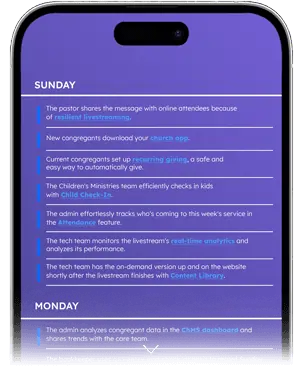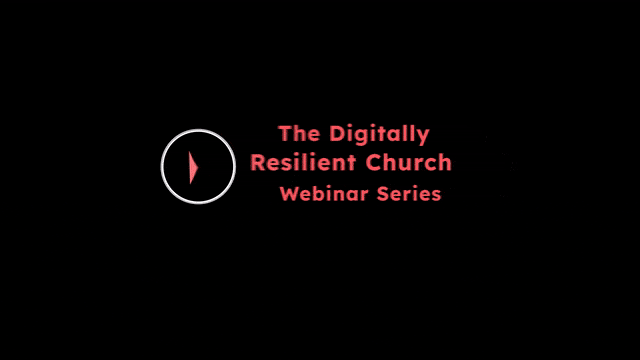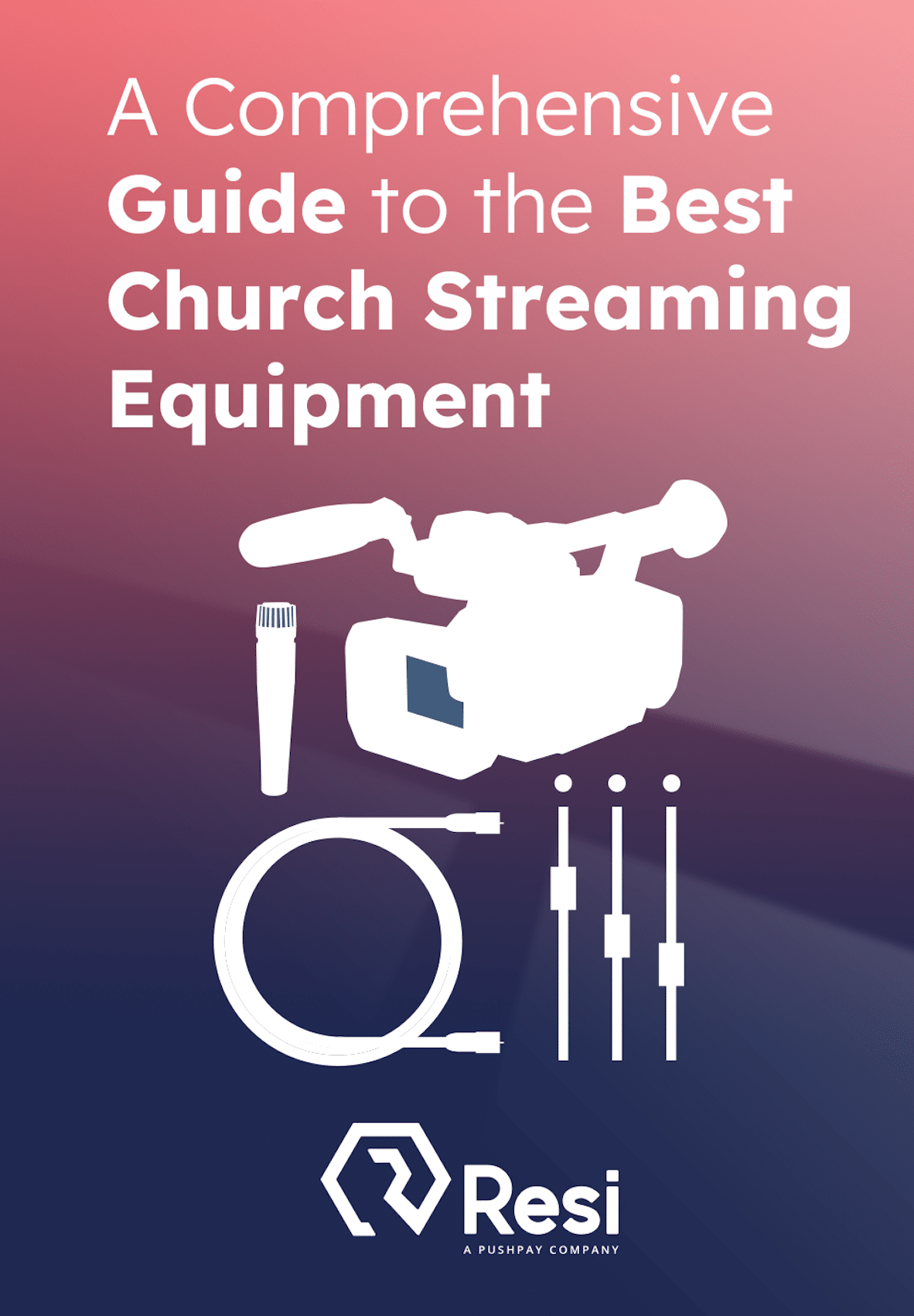
From a technical perspective, livestreaming church services is relatively easy —especially if you’re using Resi technology. Unfortunately, questions like “Who is watching?” and “What do they want?” aren’t so easy to answer.
However, the answers to those questions are extremely important when trying to figure out how to increase church engagement and attendance online.
Your online church attendees
Before we dig deeper, let’s review the three different types of people who are attending your church service online: Front door, side door, and digital door people. Each of these visitor types are looking for different things.
- The Front Door (first-time visitor) is curious about your church. They’ll watch as many as six online services before entering your building.
- The Side Door person (regular attendee) is passionate about your church, even on weeks they’re not in your building.
- The Digital Door person (never going to your physical building) is looking for relationship, care, and discipleship… if you’re willing to provide those digitally.
The challenge of increasing online church attendance starts with a simple question: Who are the people attending your services online, and what do they want?
Increasing Church Attendence Starts with Understanding the Online Congregation
Privacy laws make answering the question of “who is watching?” rather complicated, but we can get closer than we think with a little bit of deduction and logical reasoning. Let’s start with a simple question for the average church that will lead us to a safe assumption.
Since artificial intelligence can’t get a complete biographical workup from the user watching our service (yet), you can look at which platform from which they’re watching the church service and derive some helpful data. For example, users on Facebook tend to be older (Gen X, Boomer). Just like Gen Z or Gen Alpha don’t even have Facebook accounts.
We need to understand that building trust physically is much easier than digitally. That seems very counterintuitive, I know. But it’s true. People will hand over their children at a church for childcare easily but won’t even give you their email address or first name in an online form.
The best way to understand the online congregation is to ask them questions like: Who are you? How can our church serve you? What do you think about…
There’s a fascinating rule to digital ministry: It’s better to ask questions than make statements. To increase engagement, use more question marks than periods. To build digital trust with your online congregation, ask questions about them, but remember that it’ll take time to build trust.
A Week in the Life
See how Pushpay and Resi can transform how you engage with your congregation.
Download infographic
Ultimately, we need to get them talking. Rather obvious, right? To understand the online congregation, we need to listen to them!
Leveraging Church Livestreaming Technology to Build Trust
Giving people a “live” stream provides more engagement opportunities. Watching the service simultaneously with hundreds or thousands of people is a powerful, corporate-body experience. Therefore, livestreaming is a crucial component to any digital ministry strategy attempting to boost online engagement.
To Chat, or Not To Chat?
Depending on who you talk to, online chat is either crucial or overrated. Some people love chat; some people view it as a disrespectful distraction.
Keep in mind from the start that only a minority outside your congregation will engage with chat, and establishing enough trust for its usage is a gradual process. However, once they begin, they tend to do so consistently.
Consider incorporating an asynchronous platform such as Slack or Discord into your tech stack. Facebook Groups can also be a valuable tool for fostering relationships and nurturing trust in a more relaxed manner. While this may appear contrary to the traditional church setting, I prefer individuals engaging in digital communities like Facebook Groups rather than just sharing their email on a connection card. Email can feel distant and impersonal. When utilized effectively, platforms like Facebook Groups offer a chance to cultivate relationships through technology.
On Demand is (Probably) More Important Than Live Video
It’s almost a digital certainty: an on-demand video attracts more viewers than a live one. The shareability of on-demand content far surpasses that of live videos. Realistically, how many individuals new to Christianity would eagerly watch a video on their phone at 9 am on a Sunday? On-demand content offers broader exposure. However, the drawback is the absence of communal engagement, as viewers watch the service in solitude.
To effectively cater to your audience, offer both live and on-demand options. Your on-demand content can feature announcements or calls-to-action tailored for an online viewership. The advantage for you lies in Resi’s comprehensive video solutions, which encompass livestreams and on-demand features. This state-of-the-art technology empowers churches like yours to present a seamless blend of live events and pre-recorded content.
Increasing Church Engagement Online with Digital Content
How Reels, Shorts, and TikTok Can Be Your Friend
Live and on-demand content is pivotal in a church’s digital strategy. However, expecting someone new to Christianity or curious about your church to watch a 60+ minute video stream is a tall order. Securing an hour of someone’s online attention is no small feat. Yet, repurposing your church service content into easily shareable clips is a simple solution. Utilizing platforms like YouTube Shorts, Instagram Reels, or TikTok can effectively introduce your content to fresh audiences.
Practically, churches can utilize AI to analyze a 40-minute sermon and extract multiple one-minute clips for various platforms. These video snippets can be effortlessly edited in a web browser, akin to editing text in a word processor. Adding captions and branding is a straightforward task in a web browser, eliminating the need for extensive video editing skills. Once the primary content is prepared, creating a short clip typically only takes about 10 minutes.
The great thing is that AI has already been developed and is super easy to use. Look at companies like Riverside.fm or Sermon Shots and find a simple solution that can open new opportunities for exposure.
For an added boost, remember to incorporate a call to action in your videos. The aim is not to disciple someone via a brief YouTube clip. That’s challenging. Instead, captivate viewers with a concise video and encourage them to delve deeper into your content. Provide a link to your digital platform or website, offering more insights into your online church. Also, consider that your audience may not necessarily be local.
Your Church’s Best Asset Is In Your Pews
The best way to get new eyes on your digital content is to ask the people loyal to your church to share it.
Think about it. The people in your physical building Sunday at 9am are super loyal to your church. They are also passionate about your sermons and worship.
Your church can leverage this loyalty each week by encouraging members to share resources on social media or send content directly to friends who could benefit from your message. While sharing a full 40-minute sermon can be effective at times, a sixty-second video clip is more likely to reach a larger audience.
Personally, I’ve noticed a striking 2000% increase in views on each of my sixty-second YouTube Shorts compared to my hour-long videos. Interestingly, my video viewership has also surged after I began repurposing shorts from longer content consistently.
A Micro Approach to Community Impact
Some churches have empowered congregants to lead micro-locations or neighborhood churches by utilizing online church services. These smaller gatherings, usually consisting of 10-25 people, provide a safe environment for individuals new to Christianity to ask questions and engage in more intimate discussions.
A popular option is to ask people to host these in their homes. However, churches like First Capital Christian in Corydon, Indiana, run over a dozen micro-locations in more local community-based, missional spots like orphanages, rehab centers, afterschool day-care centers, office buildings, and prisons. These micro-locations are completely volunteer-led with little to no staffing support. Lead Pastor Tyler Sansom, a former digital pastor, is passionate about people finding Christ, even if they’re not in the physical building.
Your Most Important Digital Call-To-Action: The Online Community
Frequently, hybrid churches tend to make their service programming unnecessarily complex, particularly in the announcements. I’ve attended church services where the pastor or deacon would stand on stage and list a multitude of events, classes, or groups to join. From new member classes to volunteering in children’s ministry, donating to the mission fund, and attending various other activities…it’s a lot, to say the least.
I won’t discuss its effectiveness in physical spaces, but the likelihood of success online is slim. Instead of making your online services overly complex, consider using one or two straightforward call-to-actions to encourage online attendees to engage. What I’ve found effective is:
- If near our campus, come to the building next Sunday, and…
- Join our online community.
You’re missing an incredible opportunity if you’re not using your online church stream to invite people to your physical building. Lifeway has told us that most first-time guests will watch online church services at least four times before visiting the physical building. Front Door online attendees are a real thing. Our digital connections can drive people to the physical community.
For virtual attendees, where does their community reside? How can a church foster digital connections for discipleship? This is where asynchronous interactions can truly empower churches. They enable pastors, leaders, and volunteers to forge meaningful bonds with individuals online, fostering opportunities for digital discipleship.
I’d argue that a church solely streaming content online without offering a digital community for discipleship is cultivating passive digital followers. The key digital asset, one that you wish your online audience to engage in, is joining a virtual community to cultivate deeper connections. Moreover, since it’s digital, you’re interacting with this audience every day of the week, not just on Sunday mornings at 9am.
A Week in the Life
See how Pushpay and Resi can transform how you engage with your congregation.
Download infographic
The Difference Between Digital Community and Online Small Groups
“We don’t need a digital community. Our church does small groups online.” The challenge here, remember, is that people trust digitally more slowly than physically. Online small groups are viable for discipleship and should play a part in everyone’s digital strategy.
However, an asynchronous community allows churches like yours to build relationships slowly over time. Within the digital community, you can give people a safe space to trust your church enough to join an online small group. Having people turn on their webcams for a Zoom online small group meeting is a big ask, but texting in an asynchronous group is perceived as much safer and an easy way to build trust.
Will people join an online small group without your church managing an online community? Sure. Will more people join an online small group after they’ve developed more trust with your church (and leaders) through a digital community like Slack, Discord, or Facebook Groups? Definitely.
So, who are these people, and what do they want? These are some simple, practical ways your church can increase its online church attendance and get the Gospel in front of the people who need to see and hear the good news of Christ.







